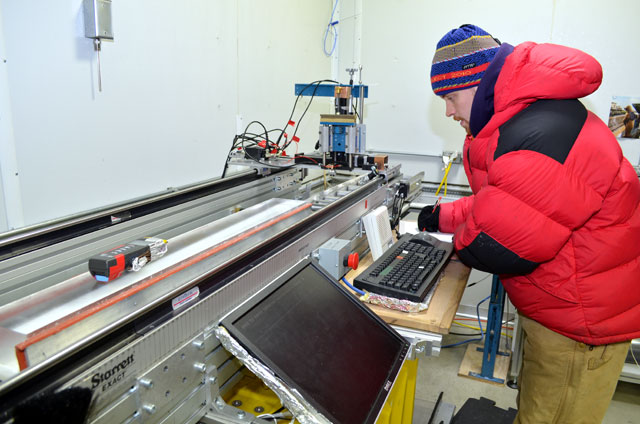Processed and packagedLast cores from WAIS Divide borehole go through NICLPosted June 29, 2012
It took a month to prepare for a week’s worth of work at the National Ice Core Laboratory (NICL) But the final sections of ice core from the West Antarctic Ice Sheet (WAIS) Divide “It’s always exciting when I think about how deep that ice is. To think we’re running more than two miles through there [in the NICL lab]. It’s a long way down,” said T.J. Fudge During the previous two summers, most of the 3,405 meters of ice drilled from a field camp in the hinterland of West Antarctica has made the long journey by plane, boat and refrigerated truck to NICL. The facility is located in the sprawling Denver Federal Center and contains an archive of nearly 20,000 meters of cores from Antarctica, Greenland and other icy regions of the planet. Over the last five years, the WAIS Divide project, funded by the National Science Foundation (NSF) However, the NSF wanted to avoid contaminating whatever sort of ecosystem may underlie the ice sheet. (A separate project, also funded by the federal agency under the U.S. Antarctic Program The goal for WAIS Divide was the ice, which scientists have dated back to 62,000 years based on preliminary analysis of the borehole itself, according to Fudge. It’s hardly the oldest ice core ever recovered. That honor goes to a European project in East Antarctica that reaches back more than 800,000 years in time. Nor is it the deepest: The Russians can make that boast of the 3,701-meter-long Vostok ice core. But the high snow accumulation rate in that region of West Antarctica has produced an ice core with uncharacteristically thick layers, which helps scientists get a very finely detailed record of past climate by analyzing a variety of properties, from atmospheric gases trapped in bubbles to the chemistry of the ice itself. Annually resolved layers reach back to 30,000 years ago, and may extend throughout the entire 62,000 year record, allowing the researchers to track climate on timescales measured in decades rather than centuries. That’s particularly important for understanding abrupt climate changes in the past, one of the main goals of the WAIS Divide project. Fudge noted that WAIS Divide ice core would also serve as a sort of Rosetta Stone for interpreting the timescales of other Antarctic ice cores. Previously, those ice cores were dated through the gas records of higher resolution ice cores in Greenland. That caused some uncertainty in the timescales on the magnitude of several centuries, he said. “With WAIS Divide, we’ll have a timescale in the ice itself, and you can tie the other ice cores directly through the ice at WAIS Divide and not have to do this gas-matchup,” he explained. “That will reduce the uncertainties in the timing to decades rather than centuries, which gives you a much better ability to look at Antarctic-wide changes.” Fudge has helped oversee the electrical conductivity measurements on the ice core, which offers a very precise way to define and date the layers of the ice core because conductivity varies seasonally. But the signal has mostly been absent after about 30,000 years, he said. “That’s huge — to be able to look at a very precise timing and duration of climate changes,” Fudge said. “It’s still hard to know what’s going to come out of the bottom ice.” Researchers who have started analyzing the upper sections of the core are already publishing significant papers, from stark decadal changes in methane concentrations (another powerful greenhouse gas) over the most recent millennium to finding signs of Europe’s Little Ice Age in Antarctica. [See related article — Global phenomenon: WAIS ice core reveals connection to Little Ice Age in Northern Hemisphere.] “We’ve got investigators who are finding things [who] want to go back into the core they just analyzed,” said Mark Twickler Twickler said he expects at least two significant studies to emerge in the next six months in major journals that may challenge orthodox interpretations of previous ice cores. He declined to go into further detail at this time. And science operations for WAIS Divide are not over yet. Researchers, engineers and ice-core drillers will return to the remote field camp next season to attempt to recover additional ice with a new instrument that will deviate from the original borehole at various depths to recover cores of particular interest, particularly related to abrupt climate change events. [See related article — Repeat experiment: New replicate ice core system will target abrupt climate change events.] Analysis of the borehole itself will continue for a couple of more years as the camp, particularly the metal arch housing the drilling operation, is disassembled and returned to the United States. A metal casing that lines the interior upper section of the borehole will be extended above the surface so that scientists can continue logging data when the arch is gone, Twickler explained. While more work remains in Antarctica and university labs across the country for years to come, there was sense for one week in June that the WAIS Divide project was coming to a close. “You’re witnessing the end of a major project,” said Brian Bencivengo, NICL assistant curator, who has also helped process the ice cores at the WAIS Divide field camp. “It’s been amazing to see.” For a complete list of all NSF-funded projects related to WAIS Divide, see the WAIS Divide webpage of funded projects
|



For USAP Participants |
For The Public |
For Researchers and EducatorsContact UsNational Science FoundationOffice of Polar Programs Geosciences Directorate 2415 Eisenhower Avenue, Suite W7100 Alexandria, VA 22314 Sign up for the NSF Office of Polar Programs newsletter and events. Feedback Form |





